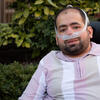This interview has been edited for length and clarity.
Why did you choose to study at Temple?
I came to grad school at Temple intending to combine my work in activism with creative outlets. Having grown up close to Philly, I had family members who attended Temple for undergrad – it was even the first college that I had been accepted to when I graduated high school, so being here for my PhD now feels like a very full-circle moment.
What do you hope to achieve in grad school at Temple?
I see this degree as something beyond myself in many ways. I have noticed that often we engage critically with race, gender, and sexuality, and those are extremely important discussions to have, but the intersection of disability with these other identities is often overlooked. My goal in grad school is to show that there is no social justice without disability advocacy. I have a lot of different projects going on which are all community and public-based and centered in disability in one way or another. My work also focuses on Philadelphia specifically and aims to help the disabled community in this city.
What have been some highlights in your experience teaching during grad school?
Most recently, I have been teaching a course called The Future of Your TV. I really like teaching this class because much of my scholarship is focused on conceptual art practice, artistic and cultural production stuff, which is really fun, but pop culture is something that I have always enjoyed throughout my life and it’s something I haven’t really gotten to focus on as a graduate student. Every week we talk about different shows with different cultural emphases – Black television events, disability in television, etc. It’s exciting to be able to teach this material and to see how passionate students can be about it.
What is a project you’ve worked on in grad school that you are proud of?
In my first semester, I took a class called Media Identity and Representation. We were given the opportunity to do a creative project, and I was really interested in creating a piece of public art representative of the disabled body in public spaces. I used a bunch of old medical equipment to print on a tapestry, then I collaborated with another Temple student to take photos of it in public spaces all around Philadelphia. Those photos were then hung up in Atelier Gallery for the Partage Exhibitions for a few weeks – my first art show. This project and experience were so meaningful to me because I have always loved to be creative, but I had felt a bit stifled until I was given the opportunity to be creative in that way.


